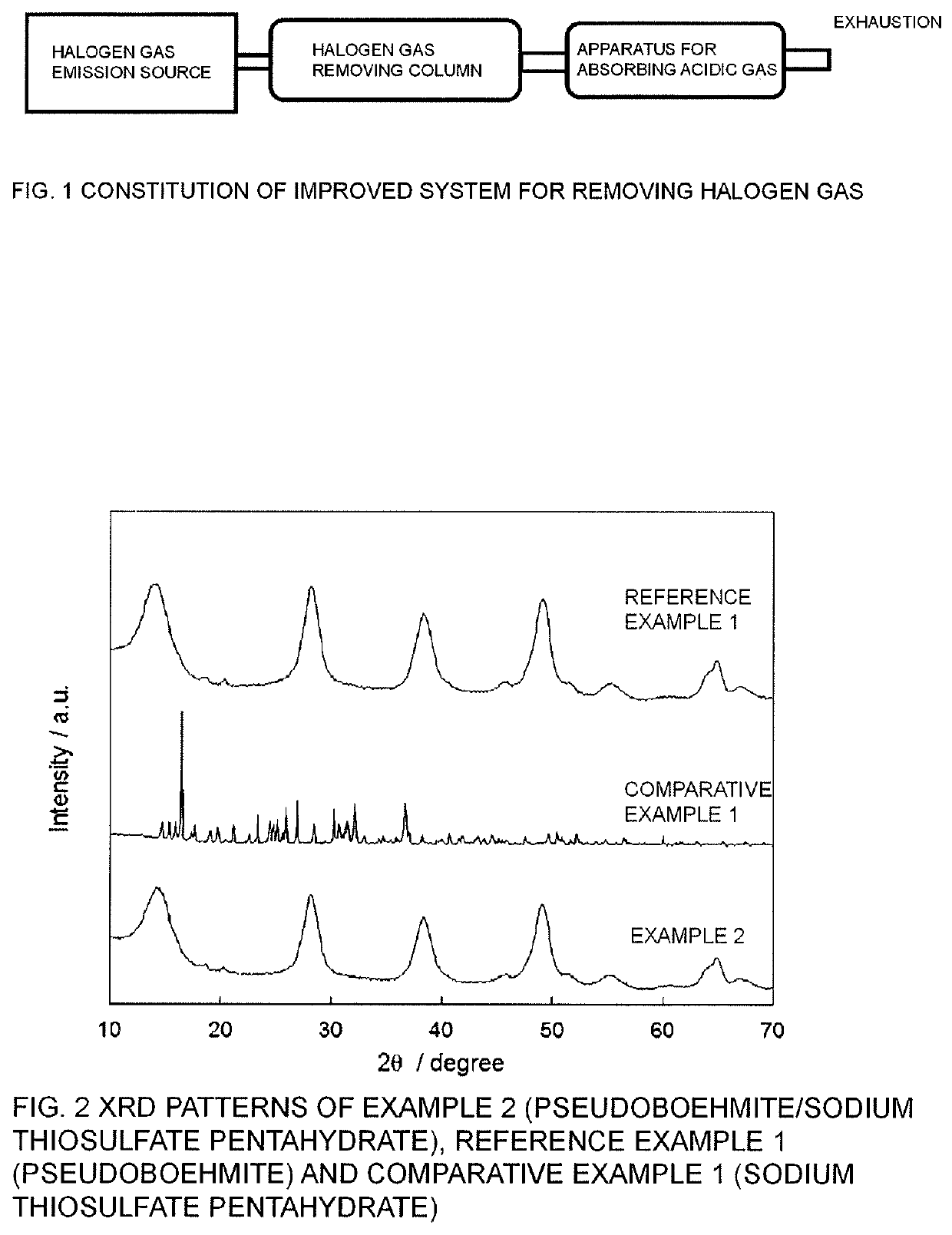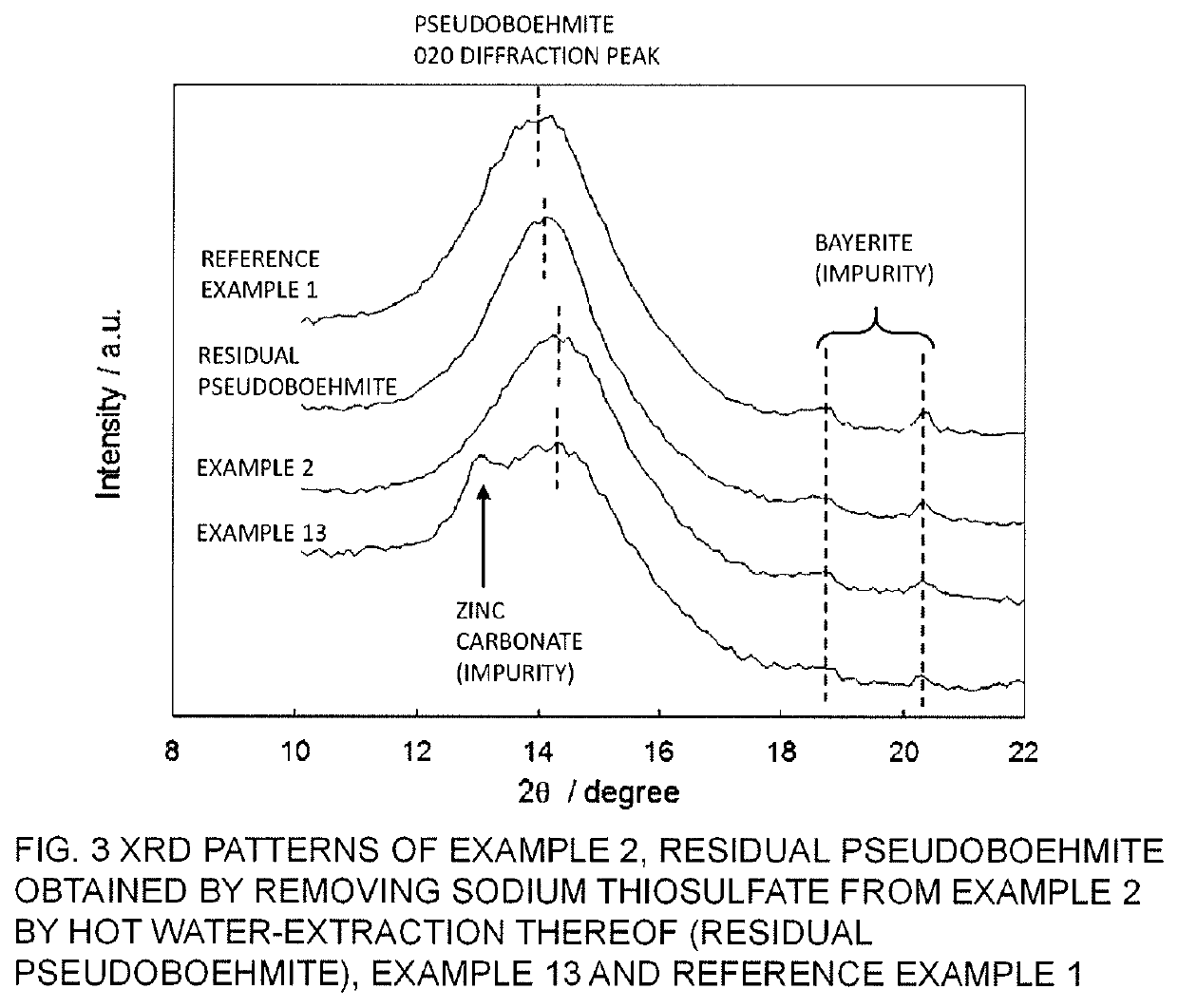Agent for removing halogen gas, method for producing same, method for removing halogen gas with use of same, and system for removing halogen gas
a technology of halogen gas and removing agent, which is applied in the field of removing agent, can solve the problems of material not meeting the requirements of higher removal ability, leakage and diffusion of waste gas, thermal runaway, etc., and achieve the effect of improving the removal ability of harmful gases
- Summary
- Abstract
- Description
- Claims
- Application Information
AI Technical Summary
Benefits of technology
Problems solved by technology
Method used
Image
Examples
reference example 1
[0103]The process for preparing a sample of Reference Example 1 was undertaken as follows. A shaped body was prepared in the same manner under the same conditions as in Example 1, except that a kneaded cake was obtained by mixing only the pseudoboehmite powder in the grinding machine while water was added thereto. The resulting sample was subjected to the measurement of sulfur atom content, the measurement of tap density and the evaluation of chlorine removing ability at 25° C. by the same methods as in Example 1, and the results are set forth in Table 1.
example 5
[0106]The process for preparing a sample of Example 5 was undertaken as follows. The same shaped body as in Example 2 was prepared in the manner as in Example 2, and then the resulting shaped body was dried overnight in an electric dryer kept at 150° C. The resulting sample was subjected to the measurement of sulfur atom content, the measurement of tap density and the evaluation of chlorine removing ability at 25° C., and the results are set forth in Table 1.
[0107]
TABLE 1Examples of halogen removing agent comprising pseudoboehmite-thiosulfate, and ReferenceExample and Comparative ExamplesDetection ofSulfursulfurous acidatomTemperaturegas beforeTemperaturecontentfor chlorinedetection ofChlorineMixing ratio amongfor dryinginremovinghydrogenTapremovingraw materialscatalystcatalysttestchloridedensityabilityEx. 190 wt %50° C.2.6 wt %25° C.yes0.86 g / ml16 L / kg pseudoboehmite10 wt % sodiumthiosulfatepentahydrateEx. 282 wt %50° C.4.8 wt %25° C.yes0.89 g / ml20 L / kg pseudoboehmite18 wt % sodium...
example 6
[0108]The process for preparing a sample of Example 6 was undertaken as follows. A pseudoboehmite powder, a sodium thiosulfate pentahydrate powder and a magnesium hydroxide powder were weighed in such a manner that the percentage composition by weight of the pseudoboehmite powder, the sodium thiosulfate pentahydrate powder and the magnesium hydroxide powder was 58%, 19% and 23%, respectively, and they were mixed using a grinding machine while water was added thereto, whereby a kneaded cake was obtained. Using a disc pelleter, the kneaded cake was shaped into a particulate shaped body having a diameter of about 2 mm and a length of about 6 mm. The resulting shaped body was dried overnight in an electric dryer kept at 50° C., thereafter placed in a desiccator and held for one hour or more to decrease the temperature to room temperature, whereby a removing agent sample of Example 6 was obtained. The resulting sample was subjected to the measurement of sulfur atom content, the measureme...
PUM
| Property | Measurement | Unit |
|---|---|---|
| diameters | aaaaa | aaaaa |
| diameters | aaaaa | aaaaa |
| temperature | aaaaa | aaaaa |
Abstract
Description
Claims
Application Information
 Login to View More
Login to View More - R&D Engineer
- R&D Manager
- IP Professional
- Industry Leading Data Capabilities
- Powerful AI technology
- Patent DNA Extraction
Browse by: Latest US Patents, China's latest patents, Technical Efficacy Thesaurus, Application Domain, Technology Topic, Popular Technical Reports.
© 2024 PatSnap. All rights reserved.Legal|Privacy policy|Modern Slavery Act Transparency Statement|Sitemap|About US| Contact US: help@patsnap.com










